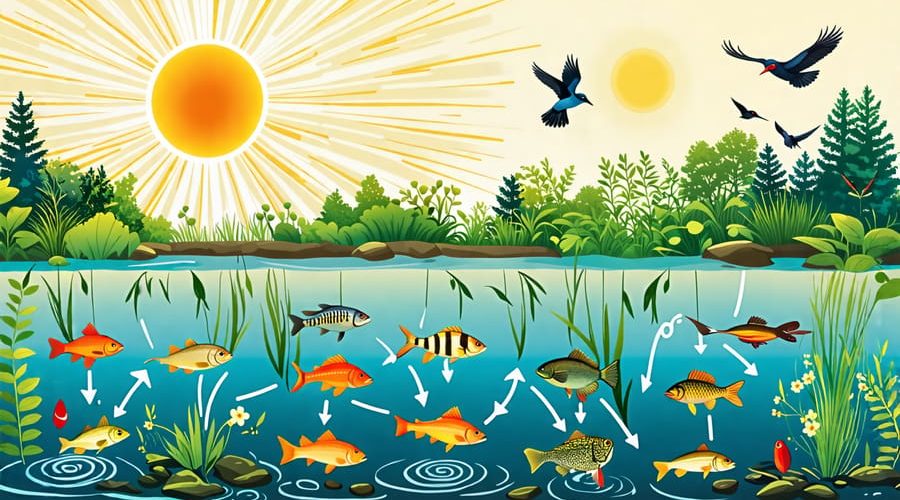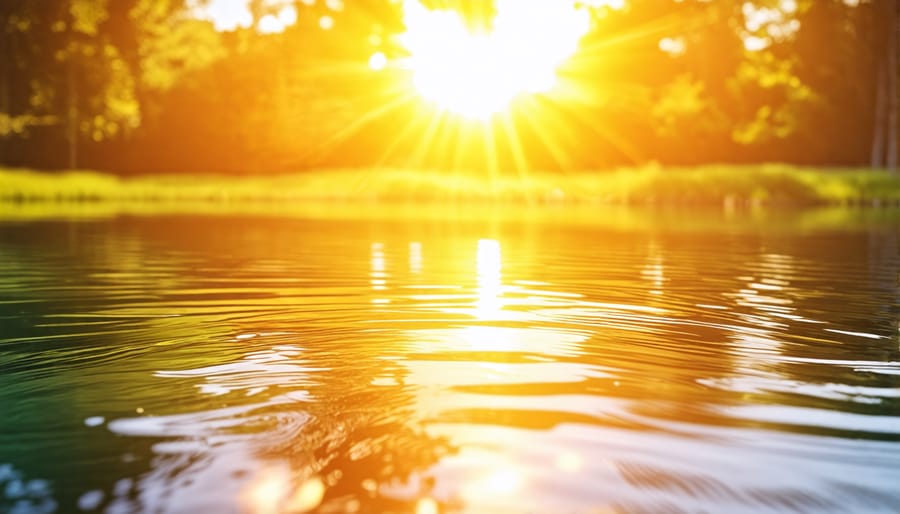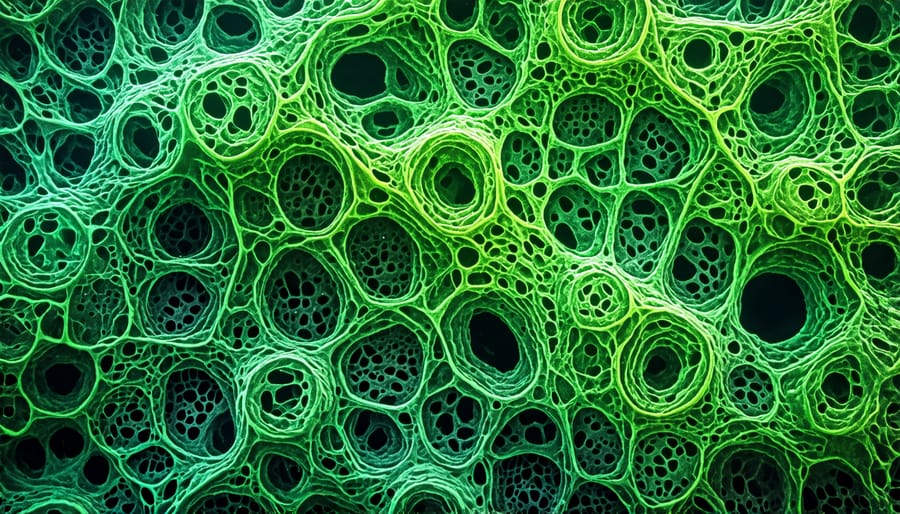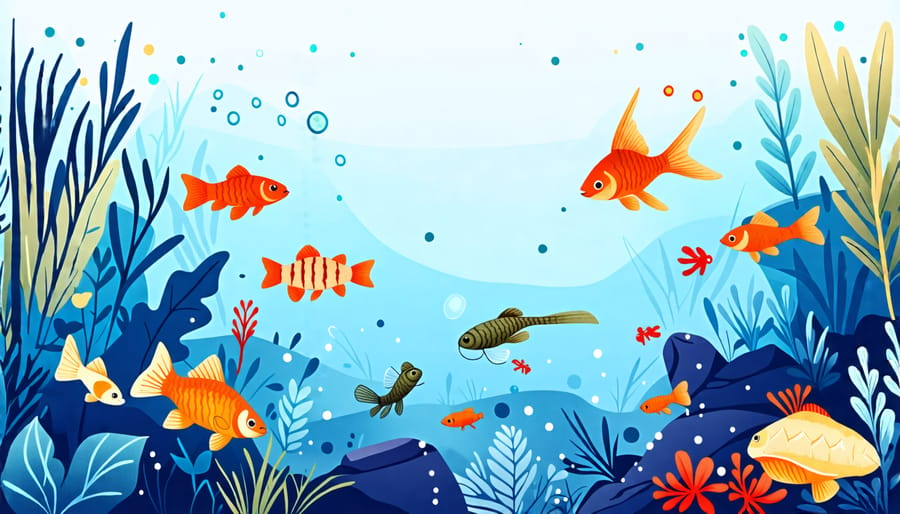
Exploring the Marvels of a Pond’s Food Chain: Dive Into Nature’s Aquatic Symphony
A pond ecosystem is a delicate balance of producers, consumers, and decomposers, all connected through an intricate food chain. At the base are the primary producers – algae and aquatic plants that harness sunlight to create energy. Zooplankton, small fish, and insects feed on this vegetation, becoming primary consumers. Larger fish, amphibians, reptiles, and birds then prey on the primary consumers as secondary and tertiary consumers. Finally, bacteria and fungi break down dead organisms, releasing nutrients back into the water to fuel new growth. Each link is crucial – a disruption at any level cascades through the entire system. Understanding this complex web of relationships is key to maintaining a thriving pond ecosystem. By supporting each tier, from planting native species to managing fish populations responsibly, we become stewards of these vibrant aquatic worlds. In this article, we’ll dive deep into the pond food chain, exploring the roles and interconnections that make these ecosystems so endlessly fascinating.
The Sun: The Ultimate Energy Source
The sun is the ultimate source of energy that fuels the entire pond ecosystem food chain. Through the process of photosynthesis, aquatic plants and algae harness the sun’s rays to create the foundation of the pond’s food web. These primary producers convert sunlight into chemical energy, storing it in the form of sugars and starches within their tissues. As the sun’s energy is captured by the pond’s flora, it becomes available to the next level of the food chain – the primary consumers. Zooplankton, small crustaceans, and herbivorous fish feed on the algae and aquatic plants, transferring the sun’s energy up the trophic levels. These primary consumers, in turn, become food for larger predatory fish, amphibians, and reptiles. The sun’s role in the pond ecosystem is crucial, as it kickstarts the entire food chain. Without its energy, the primary producers would be unable to photosynthesize, and the subsequent trophic levels would collapse. The amount of sunlight a pond receives directly influences the growth and abundance of aquatic plants, which in turn affects the populations of the animals that depend on them for food and shelter. Interestingly, even organisms that don’t directly consume aquatic plants still rely on the sun’s energy. When plants and algae die, they decompose, releasing nutrients back into the water. These nutrients are then recycled by bacteria and fungi, which serve as food for other microorganisms and invertebrates, continuing the flow of energy through the pond’s complex web of life.

Producers: The Foundation of the Food Chain
Phytoplankton: Microscopic Powerhouses
Phytoplankton are microscopic algae that form the foundation of the pond ecosystem food chain. Despite their tiny size, these primary producers pack a big punch when it comes to sustaining life in the pond. Through photosynthesis, phytoplankton convert sunlight, carbon dioxide, and nutrients into organic compounds, essentially creating their own food. This process not only nourishes the phytoplankton but also releases oxygen into the water, benefiting all pond inhabitants. As phytoplankton multiply, they become a vital food source for zooplankton, small fish, and other filter feeders. Without these mighty microorganisms, the pond food chain would collapse. Phytoplankton also play a crucial role in maintaining water quality by absorbing excess nutrients that could otherwise lead to imbalances. So, the next time you peer into your pond, take a moment to appreciate the invisible powerhouses that keep the ecosystem thriving!

Aquatic Plants: Oxygenators and Shelters
Larger aquatic plants like water lilies, lotus, and submerged oxygenators play a vital role in the pond ecosystem food chain. These aquatic plants provide oxygen through photosynthesis, helping to maintain water quality for fish and other aquatic life. They also offer shelter and hiding spots for small fish, tadpoles, and invertebrates, protecting them from predators. The leaves and roots of these plants are a food source for some fish and aquatic insects, while decaying plant matter supports the growth of beneficial bacteria and contributes nutrients to the pond. Additionally, the shade created by floating leaves helps regulate water temperature and control algae growth. By incorporating a variety of aquatic plants, you can create a balanced and thriving pond ecosystem that supports a diverse array of life at different levels of the food chain.
Primary Consumers: The Vegetarians
In a pond ecosystem, primary consumers are the herbivores that feed on the producers – the algae and aquatic plants. These vegetarians come in many forms, from microscopic zooplankton drifting in the water to larger creatures like tadpoles and certain fish species. Zooplankton, such as tiny crustaceans like daphnia and copepods, are critical components of the pond food chain. They graze on the phytoplankton, the free-floating algae, effectively transferring the energy from these primary producers to the higher trophic levels. Insect larvae, such as those of dragonflies, damselflies, and midges, are another group of primary consumers. These aquatic larvae feed on algae and organic detritus, playing a vital role in the pond’s nutrient cycling. As tadpoles develop from eggs, they initially survive on the yolk sac. But as they grow, they transition into voracious herbivores, scraping algae off surfaces and consuming aquatic plants. This stage is crucial for their growth before they metamorphose into adult frogs. Some fish species, like the grass carp and the central stoneroller, are also primary consumers. These fish have specialized digestive systems that allow them to effectively process plant matter, making them key controllers of aquatic vegetation in the pond ecosystem. These diverse primary consumers not only help keep the growth of producers in check but also serve as a vital link in the food chain, providing energy for the secondary consumers that prey upon them.

Secondary Consumers: The Meat Eaters
In the realm of secondary consumers, larger fish reign supreme. Bass, pike, and trout are adept predators, using their size and speed to hunt down minnows, tadpoles, and insects. These skilled hunters play a vital role in maintaining the delicate balance of the pond ecosystem. Amphibians also join the ranks of secondary consumers. Frogs and salamanders feast on the abundant primary consumers, such as zooplankton, snails, and small crustaceans. As they grow, they graduate to larger prey like tadpoles and small fish. Their presence adds diversity to the pond’s food web. Not to be overlooked, certain insects also qualify as secondary consumers. Diving beetles, giant water bugs, and dragonfly nymphs are fierce predators in their own right. They ambush and devour unsuspecting primary consumers, including mosquito larvae, water fleas, and small tadpoles. These aquatic insects are essential for keeping populations in check. The role of secondary consumers is to transfer energy from the primary consumers to the higher trophic levels. They serve as a crucial link in the food chain, ensuring that energy flows efficiently through the ecosystem. Without them, the pond’s delicate balance would be disrupted, leading to potential overpopulation of primary consumers and a scarcity of resources for top predators. As pond enthusiasts nurture their aquatic habitats, understanding the intricate relationships between secondary consumers and their prey is essential. By providing a diverse environment with plenty of hiding spots and vegetation, pond owners can support a thriving community of secondary consumers, contributing to the overall health and stability of the ecosystem.
Tertiary Consumers: The Top Predators
At the top of the pond food chain are the tertiary consumers – the apex predators that keep populations of secondary consumers in check. Herons are a common sight at ponds, using their long legs and sharp beaks to hunt for fish, frogs, and crayfish. These majestic birds patiently stalk their prey before striking with lightning speed. Otters are another charismatic tertiary consumer found in some pond ecosystems. These playful mammals are skilled hunters, using their agility and keen senses to catch fish, amphibians, and even small mammals. Otters play a crucial role in maintaining the balance of the pond food web. Large fish, such as bass and pike, are also top predators in the pond ecosystem. These powerful swimmers use their size and speed to hunt smaller fish, as well as insects, crustaceans, and amphibians. Some large fish may even prey on the young of other top predators, like herons. The presence of these tertiary consumers is a sign of a healthy, diverse pond ecosystem. They help prevent any one population from becoming too abundant and consuming all the resources. By keeping the secondary consumers in check, tertiary consumers maintain the delicate balance that allows the pond food chain to thrive. As a pond lover or water gardener, observing these magnificent creatures in action is a thrilling reminder of the complex web of life that exists beneath the surface of your pond.
Decomposers: Recycling Nutrients
At the bottom of the pond food chain, decomposers like bacteria and fungi play a vital role in recycling nutrients back into the ecosystem. These often-overlooked organisms are essential for maintaining the balance and health of the pond environment. When plants, algae, and animals in the pond die, they sink to the bottom where decomposers get to work. Bacteria and fungi secrete enzymes that break down the complex organic compounds in the dead matter, releasing simpler nutrients like carbon, nitrogen, and phosphorus back into the water and sediment. These recycled nutrients are then taken up by primary producers like phytoplankton and aquatic plants, which use them for growth and photosynthesis. In this way, decomposers close the loop in the pond food chain, ensuring that essential elements are not lost but instead continuously cycled through the ecosystem. Without decomposers, dead organisms would accumulate at the bottom of the pond, and nutrients would become trapped and unavailable to support new life. By breaking down this organic matter, decomposers not only clean up the pond but also provide the building blocks for the growth and survival of all the pond’s inhabitants. So, the next time you peer into your backyard pond, remember to appreciate the tiny but mighty decomposers working tirelessly to keep the ecosystem thriving. Their behind-the-scenes role in recycling nutrients is what allows the intricate web of life in the pond to continue, from the smallest algae to the largest fish.
Conclusion
The pond ecosystem food chain is a fascinating web of interconnected organisms, each playing a crucial role in maintaining the balance and health of the pond environment. From the tiniest algae to the largest predatory fish, every creature has its place in this intricate network of energy transfer. By understanding the relationships between producers, consumers, and decomposers, we gain a deeper appreciation for the delicate balance that sustains life in and around our ponds. As pond owners and enthusiasts, it’s essential to recognize the importance of preserving this natural harmony. By maintaining water quality, providing diverse habitats, and avoiding the introduction of invasive species, we can support a thriving pond ecosystem. Our efforts to create and maintain healthy ponds not only benefit the aquatic life within them but also contribute to the overall ecosystem health of our surroundings. In conclusion, the pond ecosystem food chain is a remarkable example of nature’s ingenuity and resilience. By nurturing and protecting these aquatic oases, we not only enhance the beauty of our gardens but also play a vital role in conserving biodiversity and promoting ecological balance. As stewards of these captivating ecosystems, let us continue to learn, appreciate, and preserve the wonders of the pond food chain for generations to come.
